|
Ships and other
Seafaring Vessels
|
|
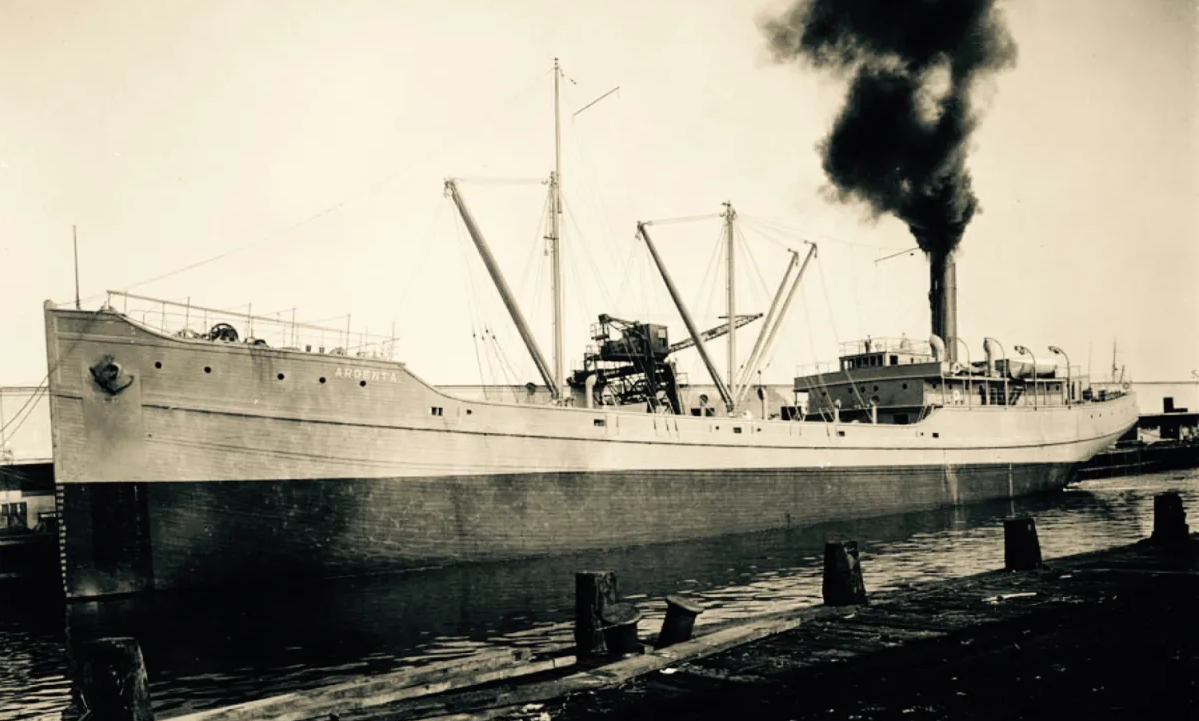
Prison
Ship HMS Argenta
HMS Argenta (originally the
American cargo ship S.S. Argenta) was a prison ship of the British Royal
Navy.
The two deck steamer was laid down
in July 1917 by the National Shipbuilding Company of Orange, Texas as
Hull No. 245. Shortages of materials meant that she was wooden-hulled,
with a steel keelson, stem and stern posts of oak, and timbers largely
of yellow pine. This was due to shortages of metals. S.S. Argenta was
launched in July 1919.
Argenta’s career as a cargo ship
was short. As early as November 1919, there were some signs of leakage,
and the ship was out of service as of late 1921. Condemned and declared
unseaworthy in May 1922, she was then sold for use as a prison ship (a
prison hulk) by the British Royal Navy.
During the 1920s, the vessel was
used by the British government as a military base and prison ship for
holding Irish Republicans as part of Britain’s internment strategy
following the events of “Bloody Sunday” in 1920.
By February 1923, under the 1922
Special Powers Act the British were detaining 263 men on the Argenta,
which was moored in Belfast Lough. This was supplemented with internment
at other land based sites, such as Larne workhouse, Belfast Prison and
Derry Gaol. Together, both the ship and the workhouse alone held 542 men
without trial at the highest internment population level during June
1923.
Conditions on the prison ship
Argenta were “unbelievable” according to Denise Kleinrichert who wrote
the hidden history of the 1920s’ “floating gulag” in Republican
Internment and the Prison Ship Argenta, 1922.
Mere paragraphs and footnotes have
decided the fate of the men and women as that deserving of ‘Sinn Féiners’.
300 men were arrested within a 24-hour period beginning near midnight on
22 May 1922, almost all nationalist and pro-Treaty but with professional
and economic status within their respective communities. Over 900 men
and women in the North were eventually ordered lifted by James Craig,
Prime Minister of Northern Ireland, under the Civil Authorities (Special
Powers) Act between the years 1922 and 1925. The analysis of the
detention without legal recourse has spanned over three years of
research of public and private archives. Interviews with former
internees and countless descendants of internees provide an interesting
exposé. The words, writings and drawings of innumerable men interned
aboard the prison ship, HMS Argenta, together with those at Larne
Workhouse Camp unfold the miseries of a two-year ordeal. The lives of
the internees were impacted beyond their captivity. Malnourishment,
disease and death, physical abuse, public abandonment, hunger strike,
prayer and escape bids served to foment the direction of their lives.
In 2011 a rare and unusual
autograph book from the Argenta, with a large number of signatures of
prisoners, almost all with Northern Ireland addresses, mostly late 1922,
was auctioned by Mealys Rare Books Limited. Signatures include Mícheál
mac Eochaidh, W. Quillan, Packie Murphy, J.P. Kearns, Michael Carraher,
Charlie Magee, Peter Rafferty, Mick McIlhatton, Frankie Corr, Owen
Montague (Patronymic Teague; Co Tyrone,) John Grimes, John Bell, Joseph
McKenny, Michael O’Neill, Liam Ua Donngaile, Art Mac Partolon (quoting
Shakespeare), F.G. Duffy, Jim Rooney, Seosamh O Cianain, and Patrick
Gormley.
An inscription from the book is:
‘When you are on some lonely road, Waiting some friends to see, Let your
thoughts turn towards the Argenta, And sometimes think of me ..’ —
Frankie Corr
As a result of author Denise
Kleinrichert’s lobbying efforts, the files of all the internees — most
of them named in an appendix to her book — are now available for viewing
at the Public Record Office of Northern Ireland (PRONI).
A must read by Author, Denise
Kleinrichert:
http://www.goodreads.com/book/show/883183.Republican_Internment_and_the_Prison_Ship_Argenta_1922
Photo: S.S. Argenta (Design 1006).
This Daugherty-type ship was built by the National S.B. Co., Orange,
Texas. She is shown here around the time of her completion on 30 July
1919. |
|
SS Georgette
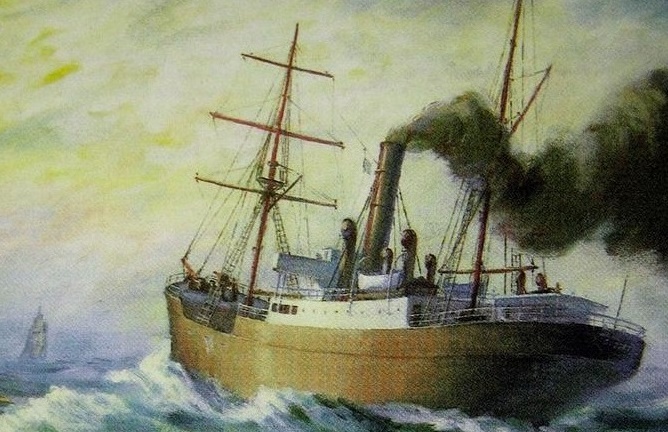 1876, the American whaling ship Catalpa rescued a
group of Fenian political prisoners from Fremantle. Catalpa had dropped
anchor in international waters, and dispatched a whaleboat to shore to
collect the escapees. The escape was detected while the escapees were
still rowing back to Catalpa, and Georgette was sent with a water police
cutter to intercept them. However, the prisoners successfully reached
Catalpa, and having no official orders to board Catalpa, Georgette and
the police cutter withdrew. The following morning, Georgette returned
and demanded the return of the prisoners. Catalpa's captain, George
Anthony, denied that he had the prisoners on board, and pointed out that
he was in international waters. Georgette then fired a warning shot with
its 12 pounder (5 kg) cannon, but Anthony pointed at his ship's US flag
and sailed away. Georgette pursued until it was low on fuel, then
returned to Fremantle. 1876, the American whaling ship Catalpa rescued a
group of Fenian political prisoners from Fremantle. Catalpa had dropped
anchor in international waters, and dispatched a whaleboat to shore to
collect the escapees. The escape was detected while the escapees were
still rowing back to Catalpa, and Georgette was sent with a water police
cutter to intercept them. However, the prisoners successfully reached
Catalpa, and having no official orders to board Catalpa, Georgette and
the police cutter withdrew. The following morning, Georgette returned
and demanded the return of the prisoners. Catalpa's captain, George
Anthony, denied that he had the prisoners on board, and pointed out that
he was in international waters. Georgette then fired a warning shot with
its 12 pounder (5 kg) cannon, but Anthony pointed at his ship's US flag
and sailed away. Georgette pursued until it was low on fuel, then
returned to Fremantle.
|
|
HMY Helga
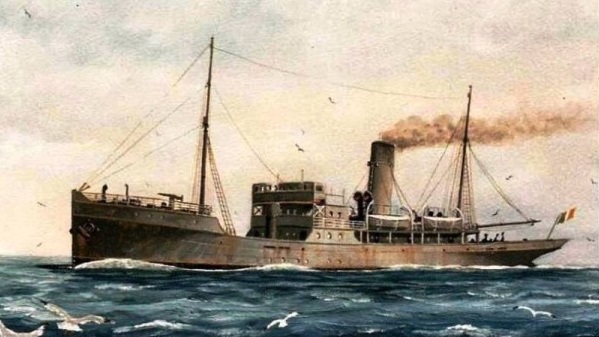 The HMY Helga is best known for its
role in the shelling of Dublin during the 1916 Easter Rising. The HMY Helga is best known for its
role in the shelling of Dublin during the 1916 Easter Rising.
The 323 ton, 155 foot long ship,
originally named the Helga II, was built in the Liffey Dockyard
in Dublin in 1908 as a fishery patrols and marine research
vessel.
She was taken over by the British
Admiralty in 1915, renamed the HMY Helga, and put
into service as an anti-submarine patrol vessel and an armed
escort.
During the 1916 rising, she was used to
shell various Irish Volunteers
positions throughout Dublin from her position in the River Liffey. The
first target fired on with her 12 pound artillery guns was
Liberty Hall, the headquarters of the Citizen Army. Her aim was less than accurate
resulting in the destruction of many of the
surrounding buildings.
She also targeted the General
Post Office and Boland's Mills.
The vessel was given to the Irish Free
State in August 1923 and renamed
Muirchú
|
|
Kelpie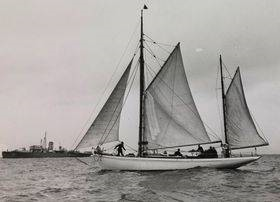
On the 3rd of July 1914,
the Kelpie, captained by Conor O’Brien and the Asgard, captained by
Erskine Childers, both travelled to the North sea
to meet the German tugboat Gladiator. The cargo of rifles
and bullets were split between the two boats with 600 mauser
rifles and 20,000 rounds going on to the Kelpie and the rest
on the Asgard.
On the 26th of July 1914 the Asgard landed in Howth and were
met by a jubilant crowd of 800 members of the Irish
Volunteers. This gun landing had a dual purpose, also acting
as a public demonstration in response to the Unionists gun
landing at Larne.
The Kilcoole gun
landing operation, however, was kept quiet. After the Kelpie
split ways with the Asgard it was met by the Chotah, a yacht
owned by Sir Thomas Myles, the president of the Royal
College of Surgeons, off the Llyn Peninsula in Wales and
offloaded her armament. The Chotah held on to the cargo
while the Kelpie sailed across the Irish Sea acting as a
decoy for the Asgard.
The Chotah continued the
journey and a week later under the cover of darkness the
guns were offloaded to the beach where they were met by a
small number of volunteers and their supporters who hurried
away with the guns in the night to be stashed and stored
away.
Source:
http://coastmonkey.ie/kilcoole-gun-running/
|
|
SS Lady
Wicklow
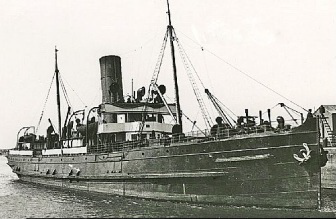
SS
Lady Wicklow was a
steamship built in 1890 in Belfast, Ireland for the
City of Dublin Steam Packet Company. This ship was
262 feet long and had a beam of 34 feet.
She was
used as a troopship for the Irish Free State to
transport 450 officers and men to Fenit, the port of
Tralee, during Irish Free State offensive of the
Anglo-Irish Treaty War.
In anticipation of such a landing, the opposing
Republican forces had rigged the pier with
explosives to blow it up. However, the set charges
were rendered inoperable by unknown Free State
collaborators, thus allowing the landing to
proceed
unimpeded.
During the landing,
that took place on
August 2, 1922, the
Lady Wicklow was shadowed by a British Warship
prepared to lend support if the landing went awry
for the Free State forces that consisted mostly of
unemployed ex-British soldiers discharged after the
WWI.
The armored vehicles, munitions
etc., used by the Free State during the landing was
part and parcel of the weaponry handed over to them by the departing British army.
As the nascent Free State had no money
in its coffers, its
army's paymaster was the British exchequer.
|
|
The
Neptune
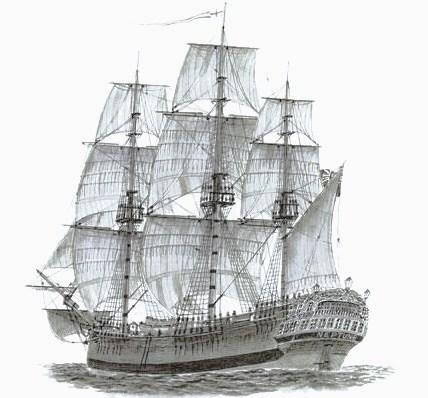 The
Neptune was one of
the notorious convict ship of the Second Fleet that
sailed to Port Jackson (Sydney Harbour). Built in the River
Thames in 1779, at 809 tons she was the largest ship of the
fleet. The other ships were the Surprize and Scarborough. The
Neptune was one of
the notorious convict ship of the Second Fleet that
sailed to Port Jackson (Sydney Harbour). Built in the River
Thames in 1779, at 809 tons she was the largest ship of the
fleet. The other ships were the Surprize and Scarborough.
The fleets first voyage
to Port Jackson was on January 19, 1790. The treatment of
convicts aboard the Neptune was unquestionably the most
horrific in the history of transportation to Australia.
Convicts suspected of petty theft were flogged to death;
most were kept chained below decks for the duration of the
voyage; scurvy and other diseases were endemic; and the food
rations were pitiful. During the voyage 31% of the
"convicts" died as the result of ill treatment.
John
Mitchel who was convicted and sentenced to
transportation for fourteen years under the Treason Felony
Act of 1848 by the British usurper in Ireland was sent from Dublin
on board HMS Scourge to Spike Island in Cork harbor where
he was incarcerated for three days. From there he was
transported to Van Dieman's Land, (now Tasmania).
After spells in the hulks
(skeleton ships) in Bermuda he was placed aboard the Neptune
bound for Cape of Good Hope in the southern tip of Africa.
The colonists refused to allow the Neptune to berth
there and after five months at anchor in Simon's Bay she
sailed to Van Diemen's Land docking at Hobart Town in April
1850.
|
|
The Hougoumont
 The Hougoumont was the last convict ship to transport convicts to
Australia. It’s most famous voyage was on October 12th 1867
when it transported 218 convicts, 62 Fenian prisoners
and 108 passengers. The Hougoumont was the last convict ship to transport convicts to
Australia. It’s most famous voyage was on October 12th 1867
when it transported 218 convicts, 62 Fenian prisoners
and 108 passengers.
On January 9 1868 the ship docked at Fremantle,
Western Australia .During the voyage, many of the Fenians
entertained themselves by producing seven editions of a
shipboard newspaper entitled The Wild Goose, which today can
be viewed in the State Library of New South Wales.
A number of journals of
the voyage exist including those of Denis Cashman and
John Casey. The memoirs of
Thomas McCarthy Fennell
have recently been discovered and published.
Numerous letters
survive, and many articles about the voyage were later
written by Fenians who went on to become journalists
including such notables as
John Boyle O'Reilly
|
|
The
Catalpa
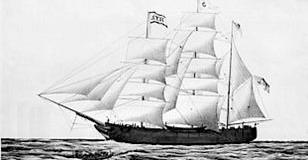 The whaling ship
Catalpa set out from New Bedford,
Massachusetts, on the morning of
April 29, 1875, to undertake a
daring yearlong mission of
international rescue. American
captain George Anthony risked
his career as a whaler and his
life to rescue a group of
British-soldiers-turned-Irish-rebels
known as “The Fremantle Six”
from their prison in Australia.
With the help of the prison
chaplain, the six men escaped to
the coast where Anthony was
waiting with a small whaleboat
that would take them to the
Catalpa. The resistance they
overcame, both from armed
British vessels and a furious
sea storm, made their escape the
stuff of legend. In what Britain
considered a near act of war,
the Catalpa outran the Royal
Navy and deposited its
politically dangerous cargo in
New York Harbor in August 1876. The whaling ship
Catalpa set out from New Bedford,
Massachusetts, on the morning of
April 29, 1875, to undertake a
daring yearlong mission of
international rescue. American
captain George Anthony risked
his career as a whaler and his
life to rescue a group of
British-soldiers-turned-Irish-rebels
known as “The Fremantle Six”
from their prison in Australia.
With the help of the prison
chaplain, the six men escaped to
the coast where Anthony was
waiting with a small whaleboat
that would take them to the
Catalpa. The resistance they
overcame, both from armed
British vessels and a furious
sea storm, made their escape the
stuff of legend. In what Britain
considered a near act of war,
the Catalpa outran the Royal
Navy and deposited its
politically dangerous cargo in
New York Harbor in August 1876.
|
|
The Fenian Ram
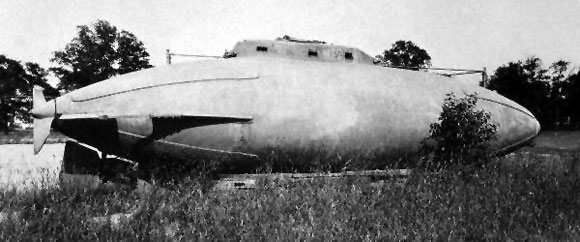 The Fenian Ram is the second
experimental submarine built by Irish-born inventor and
educator John
P. Holland. It was financed by the Fenian
Brotherhood that sought Ireland's independence from British
rule. The Fenian Ram is the second
experimental submarine built by Irish-born inventor and
educator John
P. Holland. It was financed by the Fenian
Brotherhood that sought Ireland's independence from British
rule.
Two years of experimentation
that began with a dockside submergence test in June 1881. By
mid-1883, he was conducting regular experimental trials as
far south as the Narrows of New York Harbor and along the
Brooklyn shore, achieving a surface speed of nine knots and
submerging as deep as 50 feet. Holland also staged several
successful demonstrations of the pneumatic gun, projecting a
dummy warhead both underwater and through the air to
distances of several hundred yards. In parallel, he
continued tinkering with his design, incrementally improving
maneuverability, speed, and range. It led Holland to perfect
four other experimental craft that eventually resulted in
his Holland submarine of 1898, which was adopted by the U.S.
Navy and commissioned as SS-1.
The Fenian Ram was placed in
Paterson's West Side Park in 1928 as a monument to the
inventor. In 1980, it was moved inside the Paterson Museum
where today it serves as a reminder of the ingenuity of the
"father of the modern submarine."
|
|
The SS Cuba
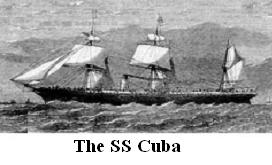 The "SS Cuba" was
a passenger steam ship that sailed the Atlantic from 1864 to 1873.
In 1871 five Fenians released from British prisons came to the
United States aboard the SS Cuba. The five,
collectively referred to as the 'Cuba Five", included
John Devoy,
Jeremiah O'Donovan Rossa,
Charles Underwood O'Connell,
Henry Mulleda, and John McClure arrived in New York to a rapturous welcome
from their fellow country men and women. The "SS Cuba" was
a passenger steam ship that sailed the Atlantic from 1864 to 1873.
In 1871 five Fenians released from British prisons came to the
United States aboard the SS Cuba. The five,
collectively referred to as the 'Cuba Five", included
John Devoy,
Jeremiah O'Donovan Rossa,
Charles Underwood O'Connell,
Henry Mulleda, and John McClure arrived in New York to a rapturous welcome
from their fellow country men and women.
The United States
congress passed a resolution welcoming the 'Cuba Five' and their fellow Fenian prisoners to the nations capital. They were also received at the White House by President Ulysses S. Grant in a gesture of gratitude for the many Irish, including senior Fenians, who had served in his victorious Union Army.
Devoy and O'Donovan Rossa went on to become
two of the most outstanding members of the Fenian movement in the USA in
the late nineteenth and early twentieth centuries.
|
|
The Asgard
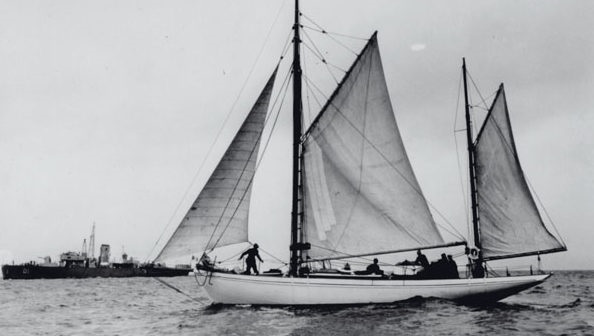 The Asgard, which
was commissioned by Erskine Childers in 1905 as a
wedding gift for his wife, Molly, was built by Colin
Archer a Norwegian boat builder and designer. The Asgard, which
was commissioned by Erskine Childers in 1905 as a
wedding gift for his wife, Molly, was built by Colin
Archer a Norwegian boat builder and designer.
On May 28, 1914 writer and
political activist Darrell Figgis and Childers
negotiated a shipment of 1,500 rifles and 49,000 rounds
of ammunition from arms firm Moritz Magnus in Hamburg.
Childers, his wife and a
small crew, made the channel crossing with 900 rifles
and 29,000 rounds of ammunition from Germany into
Howth just north of
Dublin, to arm the Irish Volunteers
in response to the arming of the
Ulster Volunteers
by the Larne gun-running
in April.
Conor O'Brien, an architect
who served in the Royal Naval Reserve during the First
World War carried the rest in his yacht The Kelpie. The
arms were transferred enroute to the Chotah and unloaded
Kilcoole in Co.Wicklow by Sir Thomas Myles, a surgeon,
barrister and politician Tom Kettle and barrister James
Meredith
|
|
The Jacknell (Erin.s Hope)

On the 12th of April, 1867, an
party of
between forty and fifty Fenians consisting mostly of former
Civil War officers and enlistees, boarded the Jacknell, a
200 ton brigantine in Sandy Hook, New Jersey and set
sail for Ireland to participate in the Fenian Rising. J. E. Kerrigan was in command of the Fenians assisted
by William J. Nagle and John Warren. The
ship's was under the command of
Capt. Cavanagh .
The ships cargo included a large quantity of firearms and a small
quantity of artillery pieces.
After nine days of sailing the
green flag of Erin was hoisted and the ship’s name changed
to Erin’s Hope. The first landing in Sligo was
abandoned after six days due to unanswered signals to
'awaiting' Fenians on shore.
Next the ship sailed south to
the alternate landing site at Helvick outside Dungarvan in Waterford where most of
the Fenians disembarked. Several more landing attempts were made
before those remaining on board decided to return to the
U.S. having learned that that the Rising had floundered.
Although Erin’s Hope did not
rendezvous with the Fenians as planned her Captain managed
to outsmart the British navy for over three
weeks while being pursued by as many as
three British navy war ships.
The voyage, which lasted 107
days and covered over 9,000 miles returned
safely to the United States with its cargo intact.
Most of the officers and men who disembarked in Helvic
including
John Warren,
William Halpin and Augustine E Costello were captured
and sentenced to long terms of imprisonment.
They were released in 1871 in response to pressure by the
Dublin Amnesty Association and U. S government
intervention.
|
|
SS Libau (SS Aud)
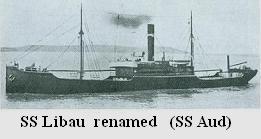
The SS Libau,
masquerading as the SS Aud, an existing Norwegian vessel, set sail from the Baltic port of
Lübeck on 9 April 1916, under the Command of
Karl Spindler. The vessel was bound for the south-west coast of
Ireland with a cargo consisting of 20,000
rifles, 1,000,000 rounds of ammunition, 10
machine guns, and explosives to support
the 1916 Easter Rising in Ireland.
It arrived off the Kerry coast on April 20 1916.
Unable to communicate with volunteers on shore,
Captain Spindler was left with no option but to abort the
mission and return to Lubeck.
The reason why contact with the shore failed was
that three of the six volunteers enroute to Kerry to handle
communications were drowned when their car took a wrong turn
and ran into the River Laune. The three volunteers who
drowned were Con Keating, Donal Sheehan and Charlie
Monaghan.
Shortly after
starting the return journey, the ship was intercepted by the
British Navy and escorted back to Cobh Harbor. Before
reaching Cobh the captain scuttled the ship with preset
explosives rather than have it fall
into enemy hands.
In the meantime, Roger Casement, who had
negotiated the arms shipment with Germany, had been put
ashore off a German U-Boat on Banna Strand on 21, April in
the hope of a rendezvous with the Aud. He was subsequently
arrested, tried for treason and executed on August 3 1916.
|
|
The Whaling ship 'Gazelle'
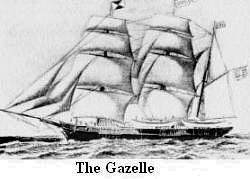
The 'Gazelle' was a
whaling ship built in New Bedford
Massachusetts in the early 1800's that plied the Pacific Ocean in search of sperm
whales. Manned by a captain and crew
supportive of the Irish in their quest for freedom from
Britain, the Gazelle played a historic role in the life of
John Boyle O'Reilly
After two years in English prisons
John Boyle O'Reilly was transported with sixty-one other
Fenians in the
Hougoumont, arriving in Western Australia on 10
January 1868.
In his first weeks at the Convict Establishment in Fremantle
he worked with the chaplain, Father Lynch, in the prison
library. O'Reilly was transferred to a road party at Bunbury
but was soon given clerical duties and entrusted to deliver
the weekly report to the local convict depot.
Befriended by the priest, Patrick McCabe, and an Irish
settler named James Maguire who was sympathetic to the
Fenian cause, O'Reilly, with their assistance, planned his
escape. Foiled in his first attempt, he hid on Maguire's
farm until he boarded the American whaler
Gazelle on
February 18, 1869. After narrowly escaping capture at
Roderiquez Island he transferred to the American
Sapphire at St
Helena and joined the Bombay as a deck-hand at Liverpool. He arrived in
Philadelphia on November 23,
1869.
|
|
back to index page |
|
The Asgard, which
was commissioned by Erskine Childers in 1905 as a
wedding gift for his wife, Molly, was built by Colin
Archer a Norwegian boat builder and designer.






 The
Neptune was one of
the notorious convict ship of the Second Fleet that
sailed to Port Jackson (Sydney Harbour). Built in the River
Thames in 1779, at 809 tons she was the largest ship of the
fleet. The other ships were the Surprize and Scarborough.
The
Neptune was one of
the notorious convict ship of the Second Fleet that
sailed to Port Jackson (Sydney Harbour). Built in the River
Thames in 1779, at 809 tons she was the largest ship of the
fleet. The other ships were the Surprize and Scarborough. The whaling ship
Catalpa set out from New Bedford,
Massachusetts, on the morning of
April 29, 1875, to undertake a
daring yearlong mission of
international rescue. American
captain George Anthony risked
his career as a whaler and his
life to rescue a group of
British-soldiers-turned-Irish-rebels
known as “The Fremantle Six”
from their prison in Australia.
With the help of the prison
chaplain, the six men escaped to
the coast where Anthony was
waiting with a small whaleboat
that would take them to the
Catalpa. The resistance they
overcame, both from armed
British vessels and a furious
sea storm, made their escape the
stuff of legend. In what Britain
considered a near act of war,
the Catalpa outran the Royal
Navy and deposited its
politically dangerous cargo in
New York Harbor in August 1876.
The whaling ship
Catalpa set out from New Bedford,
Massachusetts, on the morning of
April 29, 1875, to undertake a
daring yearlong mission of
international rescue. American
captain George Anthony risked
his career as a whaler and his
life to rescue a group of
British-soldiers-turned-Irish-rebels
known as “The Fremantle Six”
from their prison in Australia.
With the help of the prison
chaplain, the six men escaped to
the coast where Anthony was
waiting with a small whaleboat
that would take them to the
Catalpa. The resistance they
overcame, both from armed
British vessels and a furious
sea storm, made their escape the
stuff of legend. In what Britain
considered a near act of war,
the Catalpa outran the Royal
Navy and deposited its
politically dangerous cargo in
New York Harbor in August 1876.
 The Fenian Ram is the second
experimental submarine built by Irish-born inventor and
educator
The Fenian Ram is the second
experimental submarine built by Irish-born inventor and
educator  The "SS Cuba" was
a passenger steam ship that sailed the Atlantic from 1864 to 1873.
In 1871 five Fenians released from British prisons came to the
United States aboard the SS Cuba. The five,
collectively referred to as the 'Cuba Five", included
The "SS Cuba" was
a passenger steam ship that sailed the Atlantic from 1864 to 1873.
In 1871 five Fenians released from British prisons came to the
United States aboard the SS Cuba. The five,
collectively referred to as the 'Cuba Five", included

